
Edward Winter
There follows a selection of forgotten games which neatly exemplify various chess themes and recurring motifs. In most cases they may be considered ‘text-book’ material, although text books have a tendency to repeat the same old hackneyed games. Contrary to the impression sometimes given, Torre v Lasker, Moscow, 1925 is not the only existing example of the ‘seesaw combination’; nor has it yet been decreed that Bernstein v Capablanca, Moscow, 1914 is compulsory as an illustration of the ‘back-rank mate’.
***
The first game, played at rook odds, is a beautiful example of a real rarity: a double knight fork:
Gustavus Charles Reichhelm – W.W. Biddle
Occasion?
(Remove White’s rook at a1.)
1 e4 e5 2 d4 exd4 3 f4 Bb4+ 4 Kf2 Bc5 5 Bd3 d6 6 Nf3 Bg4 7 Rf1 Nc6 8 Kg3 Nf6 9 e5 dxe5 10 fxe5 Nxe5 11 Qe1 Qe7 12 Nxe5 Bd6 13 Bf4 Nh5+ 14 Kxg4 Nxf4 15 Rxf4 Bxe5 16 Re4 f6 17 Rxe5 Qxe5 l8 Qxe5+ fxe5 19 Kf5 O-O-O (Another curiosity: castling when the enemy king is up to the fifth rank.) 20 Kxe5 h6 21 Nd2 c5 22 Bf5+ Kc7 23 Ne4 Rhe8+ 24 Be6 b6 25 a4 Kc6 26 Kf5 Rf8+ 27 Kg6 Rf4 28 Bf5 Rf8 29 g4 Re8 30 Ng3 Re7 31 h4 Rf2 22 Nh5 Rh2 33 Nxg7 Rxh4 34 Nh5 Kd5 35 Kxh6 Ke5 36 Kg5 Rh1 37 Nf4 Rg7+ 38 Ng6+ Kd6 39 Kf6 Rc7 40 g5 c4 41 Ne5 Rf1 42 g6 Rg1 43 Nf7+ Kc5 44 Ng5 Rc6+ 45 Ne6+ (Cross checks are rare, but this is the second one.) 45...Kd5 46 Kf7 (Black’s next move sets the scene for a remarkable knight manoeuvre.)

46...Rxg6 47 Nf4+ Ke5 48 Nxg6+ Kxf5 49 Ne7+ Ke5 50 Nxc6+ Kd5 51 Nxa7 Kc5 52 Nb5 d3 53 cxd3 cxd3 54 Ke6 d2 55 Nc3 Kc4 56 Kd6 Kb3 57 Kc6 Kxb2 58 Nd1+ Kc2 59 Nf2 Kb3 60 Kb5 Ka3 61 Nd1 Kb3 62 Ne3 Ka3 63 Nc4+ and wins. (White concludes, appropriately enough, with a further knight fork.)
Source: Brentano’s Chess Monthly, April 1882, pages 616-617.
From Richard Forster (Winterthur Switzerland):
‘46...Rxg6 and 48...Kxf5 are gross blunders. There is an interesting point at the end: 58...Kc2 is a decisive mistake; 58...Kb3 59 Kb5 Ka3 or 59...Kc2 would have drawn.’
Gustavus Reichhelm (1839-1905) was the Games Editor of Brentano’s Chess Monthly (1881-82), a superbly produced magazine which closed down after 15 issues because the chess public was offering it only ‘slender support’.
A straightforward and effective illustration of unthinking mobilization is the following game, won by Géza Maróczy during a tour of the United States:
Géza Maróczy – Mordecai Morgan
USA, 1906
Ruy López
1 e4 e5 2 Nf3 Nc6 3 Bb5 a6 4 Ba4 Nf6 5 O-O Be7 6 Re1 b5 7 Bb3 O-O 8 c3 d6 9 d4 Bg4 10 a4
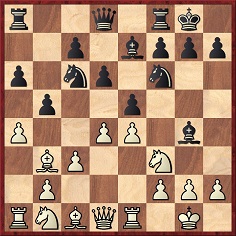
10...Rb8 (‘A decisive mistake. Black was playing mechanically and making the book moves without realizing the actual change in the position, a pawn being at c3 instead of knight’ – Maróczy.) 11 axb5 axb5 12 d5 Resigns.
Source: American Chess Bulletin, April 1906, page 76.
Maróczy is also the winner of the next game, which demonstrates how the bishop pair can dominate two knights. The brief notes are by the Hungarian himself:
Morgan Smith – Géza Maróczy
Winnipeg, 1906
Sicilian Defence
1 e4 c5 2 Nf3 e6 3 d4 cxd4 4 Nxd4 Nf6 5 Bd3 Nc6 6 Nf3 (‘More natural is 6 Be3.’) 6...Qc7 7 Nc3 a6 8 Ne2 Be7 9 O-O O-O 10 Bf4 d6 11 Ng3 Bd7 12 c3 Ne5 13 Kh1 (‘Losing a pawn and the game. 13 Bc2 was his best. Black is well developed, having overcome the opening difficulties. Either 13 Bxe5 or 13 Nxe5 by White would be inferior.’) 13...Nxd3 14 Qxd3 Bb5 15 c4 Qxc4 16 Qxc4 Bxc4 17 Rfc1 Rac8 18 Rd1 d5 19 Nd2 dxe4 20 Ndxe4 Bd5 21 Nc3 Rfd8 22 h3 Bc6 23 Rxd8+ Rxd8 24 Rd1 Rxd1+ 25 Nxd1 Nd5
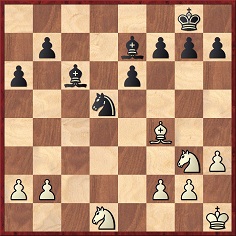
(‘The ensuing ending is very instructive and well demonstrates the strength of two bishops.’) 26 Bd2 f5 27 Ne2 e5 28 Kg1 Kf7 29 Ne3 Ke6 30 Nc3 Nf4 31 Kf1 b5 32 a3 g5 33 f3 h5 34 Na2 Bc5 35 Nb4 Bb7 36 Nec2 a5 37 Bxf4 gxf4 38 Na2 Bd5 39 Nc3 Bc4+ 40 Ke1 b4 41 axb4 axb4 42 Na4 Kd5 43 Kd2 Bf1 44 Ne1 Be3+ 45 Kd1 Kc4 46 Kc2 b3+ 47 Kd1 Bd4 48 Kd2
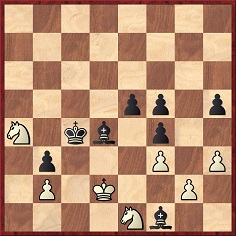
48...h4 49 White resigns.
Source: American Chess Bulletin, May 1906, page 86.
Now a game which, while illustrating the power of the two bishops, shows the value of commanding the seventh rank with rooks. It is also a worthwhile reminder that Janowsky did not always refuse queen exchanges, despite the claims of certain chroniclers.
William Ewart Napier – Dawid Janowsky
Hanover, 31 July 1902
Ruy López
1 e4 e5 2 Nf3 Nc6 3 Bb5 a6 4 Ba4 Nf6 5 O-O Be7 6 Nc3 b5 7 Bb3 d6 8 d3 Na5 9 Ne2 Bb7 10 Ng3 g6 11 Qe2 Nxb3 12 axb3 O-O 13 Bh6 Re8 14 Nd2 d5 15 Rad1 Qd7 16 h3 Kh8 17 Nf3 Bd6 18 Qd2 Ng8 19 d4 Nxh6 20 Qxh6 Bf8 21 Qg5 exd4 22 Nxd4 Bg7 23 Nf3 Qe7 24 exd5 Qxg5 25 Nxg5 Kg8 26 N5e4 Red8 27 c4 Bxb2 28 Nc5 Bc8 29 Nd3 Bg7 30 Nb4 Bb7 31 cxb5 axb5 32 Ne4 Ra3 33 Nc5 Bc8 34 Nc6 Rf8 35 Rfe1 Bf6 36 Re4 Kg7 37 Rb4 Re8 38 Rxb5 Ra2 39 Nd3 Ree2 40 Rc5 Bf5 41 Nc1 Red2 42 Rf1 Rab2 43 Rc4 Rxd5 44 Nb4 Rdd2 45 Rf4 c5 46 Nc6 Bg5 47 Rc4
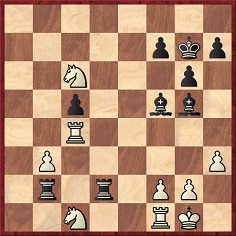
47...Be3 48 Kh1 Rxf2 49 Rxf2 Rxf2 50 Kh2 Bxc1 51 Rxc1 Be4 52 Kg1 Rxg2+ 53 Kf1 Bxc6 54 Rxc5 Bf3 55 Rc3 Ba8 56 White resigns.
Source: tournament book, pages 66-67.
From a simultaneous display by the then world champion:
Alexander Alekhine – N.M. Boekdrukker
Bussum, 1 November 1933
Sicilian Defence
1 e4 c5 2 Nf3 e6 3 d4 cxd4 4 Nxd4 Nf6 5 Nc3 Nc6 6 Be2 d5 7 exd5 exd5 8 O-O Be7 9 Be3 O-O 10 Nb3 Be6 11 Nb5 a6 12 N5d4 Re8 13 c3 Qc7 14 h3 Bd6 15 Nc5
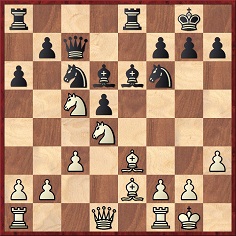
15...Bxh3 16 Nxa6 Bh2+ 17 Kh1 Bxg2+ 18 Kxg2 bxa6 19 Nxc6 Rxe3 20 fxe3 Qg3+ 21 Kh1 Bg1 22 Rf2 Bxf2 23 Qf1 Re8 24 Qg2 Qxe3 25 Bf3 Ne4 26 Nd4 Re5 27 Qh2 Bg3 28 Qe2 Nf2+ 29 Kg2 Qh6 30 Qc2 and Black announced mate in four moves.
Source: Tarrasch’s Schachzeitung, 1 December 1933, pages 69-71.
Lastly, an enthralling rook ending which the anthologists and pedagogues have neglected.
1 e4 e5 2 Nc3 Nc6 3 g3 Bc5 4 Bg2 Nf6 5 Nge2 d6 6 O-O Bg4 7 d3 Nd4 8 h3 Bf3 9 Be3 Nxe2+ 10 Nxe2 Bxg2 11 Kxg2 Bxe3 12 fxe3 h5 13 Ng1 Qe7 14 Nf3 Ng8 15 Nh4 g6 16 c3 O-O-O 17 b4 Qe6 18 Qb3 Qxb3 19 axb3 Nh6 20 Rxa7 b6 21 Nf3 Kd7 22 Ng5 Rdf8 23 Ra2 Ke7 24 Raf2 f6 25 Nf3 g5 26 Ne1 Rf7 27 b5 Ra8 28 Nc2 Rff8 29 Nb4 g4 30 h4 Ng8 31 Nd5+ Kd7 32 Nxf6+ Nxf6 33 Rxf6 Rxf6 34 Rxf6 Ra3 35 Rf5 Rxb3 36 Rxh5 Rb2+ 37 Kf1 Rb1+ 38 Ke2 Rb2+ 39 Kd1 Rb1+ 40 Kc2 Rg1 41 Rh7+ Kd8 42 h5 Rxg3 43 h6 Rh3 44 Kb3 g3 45 Kc4 g2 46 Rg7 Rxh6 47 Rxg2 Rh3 48 Rg8+ Kd7 49 Rg7+ Kd8
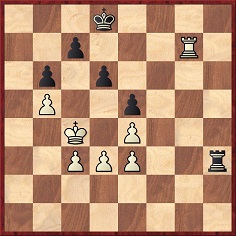
50 Kd5 Rxe3 51 Kc6 Rxd3 52 Rd7+ Ke8 53 Rxc7 d5 54 exd5 e4 55 Kd6 e3 56 c4 Kf8 57 Re7 Rc3 58 Re4 e2 59 Rxe2 Rxc4 60 Ke6 Ke8 61 d6 Rd4 62 Ra2 Re4+ 63 Kd5 Re1 64 Kc6 Rc1+ 65 Kxb6 Kd7 66 Rd2 Rb1 67 Ka6 Ra1+ 68 Kb7 Rb1 69 b6 Rb3 70 Rd5 Rb2 71 Ka7 Ra2+ 72 Kb8 Rb2 73 b7 Rb3 74 Ka7 Kc6
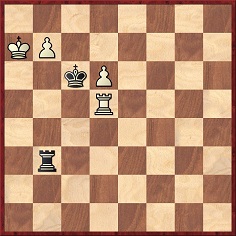
75 b8(N)+ Kxd5 76 d7 Resigns.
Source: tournament book, Hauptturnier, pages 251-152.
Magazine readers sometimes pass over lengthy games, but nobody should miss the above finale. Underpromotion in a rook ending is a very rare occurrence.
This article was originally published in New in Chess in 1998 and is also on pages 55-60 of Kings, Commoners and Knaves.
To the Chess Notes main page.
To the Archives for other feature articles.
Copyright: Edward Winter. All rights reserved.